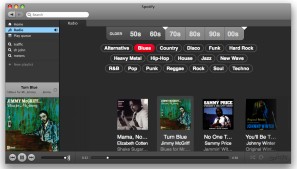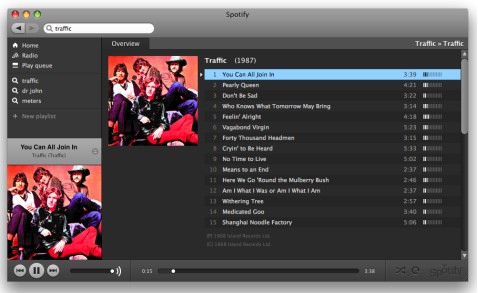 My music streaming weapon of choice used to be Pandora, the Music Genome Project-based service in which a group of experts have analyzed the component parts or ‘genes’ of thousands of tracks in order to recommend like-minded music. I not only found its recommendations (play tracks similar to artist or genre x) to be more accurate than rival Last.fm, but also loved its simple User Interface, designed perfectly for when I’m in a lazy listening mood. The problem is that Pandora stopped being accessible from the UK a while back. Enter Spotify, a new music streaming service, which this week publicly launched in the UK.
My music streaming weapon of choice used to be Pandora, the Music Genome Project-based service in which a group of experts have analyzed the component parts or ‘genes’ of thousands of tracks in order to recommend like-minded music. I not only found its recommendations (play tracks similar to artist or genre x) to be more accurate than rival Last.fm, but also loved its simple User Interface, designed perfectly for when I’m in a lazy listening mood. The problem is that Pandora stopped being accessible from the UK a while back. Enter Spotify, a new music streaming service, which this week publicly launched in the UK.

Spotify isn’t browser-based but instead offers a very nice desktop client (Mac and Windows) that has a distinctively iTunes look and feel to it. Since the service has licensing agreements with all four majors and a bunch of indies, one way to think of Spotify is as a massive jukebox in the sky (music can be streamed but not downloaded). You can search for individual tracks, albums or artists, and unlike similar ‘Internet radio’ offerings, there doesn’t seem to be any restrictions on how many tracks of the same artist can be played sequentially or how many times etc. This means that you can search for a specific album and play through the whole lot, just like your own iTunes music collection stored locally. Other features include artist-based ‘radio stations’ and the ability to create playlists. Quite brilliantly, each track is also a web link, making it easy to ‘share’ them with friends over email or IM etc. Hence some people have dubbed Spotify as Naptster meets iTunes.
See also: Will audio ads on Pandora help it swim back across the pond?
The only catch is that the free service serves up audio ads every few tracks, although paid-for ad-free subscriptions are also available. On the downside, there is no mobile client, which is a real shame as I really want this on my iPod touch.

Hmmm. I am a major Slacker fan, but I may have to try this out when I’m near the computer.